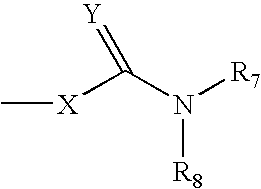Heterocyclic compounds, their preparation and their use as medicaments, in particular as Anti-alzheimer agents
a heterocyclic compound and anti-alzheimer technology, applied in the field of new heterocyclic compounds, neuro, can solve the problems of loss of therapeutic effect with time, compound instability in vivo and very rapid desactivation,
- Summary
- Abstract
- Description
- Claims
- Application Information
AI Technical Summary
Problems solved by technology
Method used
Image
Examples
example 1 preparation
OF ETHYL 1-METHYL-7-(N,N-DIMETHYLCARBAMATE)-1,4-DIHYDROQUINOLINE-3-CARBOXYLATE
[0392]
[0393]Stage A: 7-hydroxy 3-quinolinecarboxylic acid.
[0394]A solution of 3-cyano-7-methoxyquinoline (20 g, 110 mmol) [described in Tetrahedron Lett. 1998, 39 (23), 40134016] in 48% aqueous solution bromhydric acid (300 ml) is stirred and heated under reflux for 12 hours. The reaction mixture was then cooled to room temperature and neutralised by adding 20% aqueous KOH. The resulting precipitate was filtered and dried under vacuum. In this way 15.2 g (yield: 73%) of the product of molecular formula C10H7NO3 was recovered. Aspect: brown powder.
[0395]Melting point: >260° C.
[0396]NMR Spectrum of the Proton
[0397]In DMSO-d6 at 300 MHz, chemical shifts (ppm) and multiplicity: 13.28 (s, 1H), 10.68 (s, 1H), 9.20 (d, J=2 Hz, 1H), 8.84 (d, J=2 Hz, 1H), 8.06 (d, J=9 Hz, 1H), 7.34 (s, 1H), 7.29 (d, J=9 Hz, 1H).
[0398]Stage B: ethyl 7-hydroxyquinoline-3-carboxylate
[0399]To a solution of the compound obtained in stag...
example 2 preparation
OF ETHYL 1-METHYL-5-(N,N-DIMETHYLCARBAMATE)-1,4-DIHYDROQUINOLINE-3-CARBOXYLATE
[0417]
[0418]Stage A: 5-(benzyloxy)quinoline-3-carboxylic acid.
[0419]To a solution of 0.1 g (0.53 mmol) of compound prepared in stage B of example 67 in 5 mL of dry DMF was added 132 μL (1.11 mmol) of benzyl bromide and finely powdered K2CO3 (183 mg, 1.3 mmol). This mixture was stirred at 65° C. under N2 for 36 hours. The reaction was worked up by pouring the solution into water (10 mL) and ethyl acetate (10 mL). The product was extracted with ethyl acetate (3×10 mL). The organic layers were combined, washed with water and brine, and dried over MgSO4. Filtration and evaporation under vacuum gave 0.14 g of a viscous brown oil. This ester was treated with KOH (150 mg, 2.66 mmol) dissolved in 10 mL of ethanol and heated under reflux for 3 hours. After evaporation of ethanol, the product was dissolved in 5 mL of water and washed with diethyl ether (2×10 mL). The aqueous layer was neutralized with an aqueous sol...
example 3 preparation
OF ETHYL 1-METHYL-5,7-DI(N,N-DIMETHYLCARBAMATE)-1,4-DIHYDROQUINOLINE-3-CARBOXYLATE
[0463]
[0464]Stage A: 5,7-dihydroxy-3-quinolinecarboxylic acid
[0465]A solution of 3-cyano-5,7-methoxyquinoline (20 g, 110 mmol) [described in Tetrahedron Letters, 39 (23), 4013-4016, 1998] was treated as reported in stage A of Example 1. The compound of the molecular formula C10H7NO4 (MW=205.17) is obtained in 80% yield.
[0466]Stage B: ethyl 5,7-dihydroxyquinoline-3-carboxylate.
[0467]The title compound is prepared as described in Stage B of Example 1
[0468]Stage C: ethyl 5,7-di(N,N-dimethylcarbamate)quinoline-3-carboxylate. The title compound is prepared as described in Stage C of Example 1.
[0469]Stage D: ethyl 1-methyl-5,7-di(N,N-dimethylcarbamate)quinolinium-3-carboxylate triflate
[0470]The title compound is prepared as described in Stage D of Example 1.
[0471]Stage E: ethyl 1-methyl-5,7-di(N,N-dimethylcarbamate-1,4-dihydroquinoline-3-carboxylate.
[0472]The title compound is synthesized as described in Sta...
PUM
| Property | Measurement | Unit |
|---|---|---|
| Distance | aaaaa | aaaaa |
| Distance | aaaaa | aaaaa |
| Distance | aaaaa | aaaaa |
Abstract
Description
Claims
Application Information
 Login to View More
Login to View More - R&D
- Intellectual Property
- Life Sciences
- Materials
- Tech Scout
- Unparalleled Data Quality
- Higher Quality Content
- 60% Fewer Hallucinations
Browse by: Latest US Patents, China's latest patents, Technical Efficacy Thesaurus, Application Domain, Technology Topic, Popular Technical Reports.
© 2025 PatSnap. All rights reserved.Legal|Privacy policy|Modern Slavery Act Transparency Statement|Sitemap|About US| Contact US: help@patsnap.com



